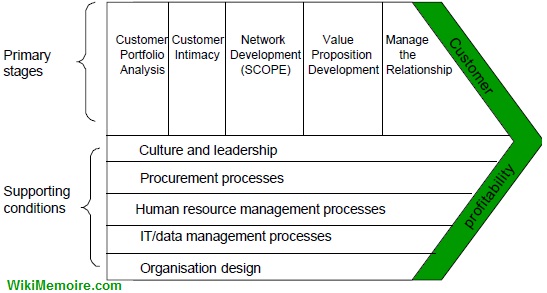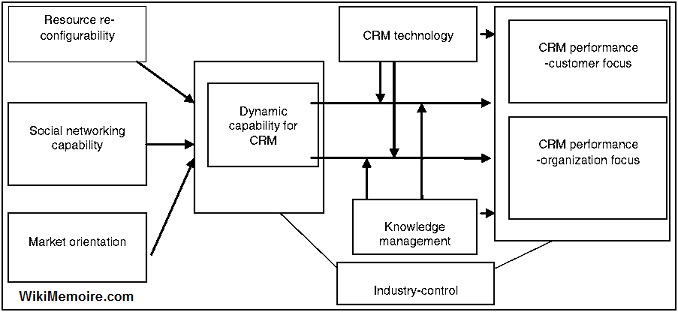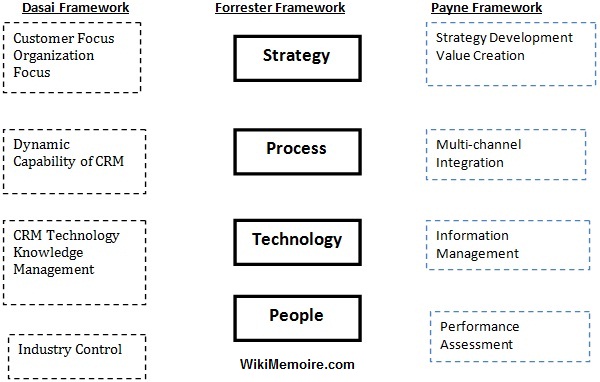The Customer Relationship Management Frameworks & Frameworks : IDIC model, QCI, Value Chain
2.2 The CRM Customer Relationship Management Frameworks/Models
A various range of comprehensive Customer Relationship Management CRM models have been developed. The author introduces five of them in this chapter.
2.2.1 The IDIC model of CRM Customer Relationship Management
The IDIC is described below (Figure 2.6)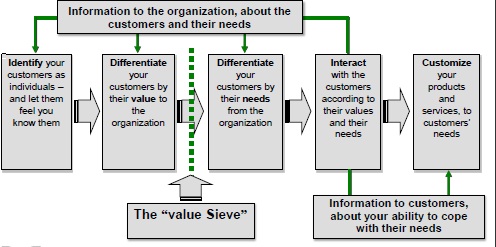
Figure 2.6: The IDIC Methodology ( Peppers and Rogers, 2004)
The IDIC Model has been developed by Peppers and Rogers (2004).
According to IDIC model, companies should take four actions in order to build closer one-to-one relationships with customers:
- Identifying who the companies’ customers are and building a deep understanding of them;
- Differentiating their customers in order to identify which amongst them have most value now and which offer most for the future.
Besides, the differentiation can allow the companies to devise and implement customer specific strategies designed to satisfy individually different customer need. The clients represent different levels of value to the company and they their needs are radically not the same from the enterprise.
According to Peppers and Rogers (2004), the customer differentiation task will involve an enterprise in categorizing its customers by both their value to the firm and by what needs they have. - Interacting with them in order to ensure that companies understand customer expectations and their relationships with other suppliers or brands.
Thus, companies must improve the effectiveness of their interactions with clients. Each successive interaction with a customer should take place in the context of all previous interactions with that customer.
A conversation with a customer should pick up where the last one left off. Effective customer interactions provide better insight into customer’s needs. - Customizing the offer and communications to ensure that the expectations of customers are met. Indeed, the company should adapt some aspect of its behaviour toward a customer, based on that individual’s needs and value.
To involve a customer in a relationship, a company needs to adapt its behaviour to satisfy the customer’s expressed needs. This might entail “mass-customization a product or tailoring some aspect of its service” (Peppers, Rogers and Dorf, 1999).
2.2.2 The Quality Competitiveness Index Model (QCI model of CRM)
QCI are independent specialists who assist blue chip companies in managing customers. They are both strategic theorist and foremost practitioners (Hewson et al, 2002). The QCI model shown below is described as below.
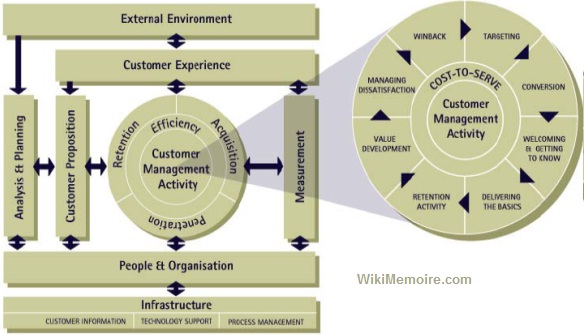
Figure 2.7: The QCI Customer Management Model (Hewson et al. l, 2002)
The above is described as a customer management model, omitting thereby the word “relationship”.
At the center of the model, they highlight a range of activities needed by companies to perform in perspective to acquire and retain customers. This model also features people performing processes and utilizing technology to assist in those activities.
2.2.3 The CRM Value Chain Model
The CRM value chain (figure. 2.7) is a model which businesses can follow when developing their CRM strategies (Buttle, 2004).
This model had been developed by a range of SMEs such as IT, software, telecoms, financial services, retail, media, manufacturing, and construction. This model is built from strong theoretical principles and the practical requirements of business.
Figure 2.8: The CRM Value Chain (Buttle, 2000)
The main purpose of this model is, according to Buttle (2004), to ensure that the company builds long-term mutually-benefical relationships with its strategically-significant customers. Thus, some customers are merely expensive to acquire and service.
Buttle has identified four types of strategically significant customer (SSC) such as the high life-time value customer that is a key SSC and the present day of all margins that might be earned in a relationship.
He stated that tempting as it may be to believe, not all high volume customers have high LTV. If they demand JIT, customized delivery, or are in other ways costly to serve, their value may be significantly reduced.
We know of one company that applied activity-based costing disciplines in order to trace process costs to its customer base […] as consequence the company re-engineered its manufacturing and logistics processes, and salespeople negotiated price increases The second group of SSC is according to the above author “benchmarks” that are customers that other ones copy.
For instance, a manufacturer of vending machine equipment is prepared to do business with any company because “they can tell other customers that they are supplying to the world’s biggest vending operation” (Buttle, 2000).
The third group of SSCs are customers ‘inspirations’. They are the ones that find new applications, “come up with new product ideas, find ways of improving quality or reducing cost. The may be the most demanding of customers, or frequent complainers, and though their own LTV potential low, they offer other significant sources of value”.
The fourth one deal with what Buttle (2004) calls “cost magnets” relating to those that absorb a disproportionately high volume of fixed cost, thus enabling other, smaller customers to become profitable John Stevenson (2007), asserts that the CVC includes four stages:
- The first stage deals with grouping customers in order to determine which of customers are most profitable.
The result the companies should seek is their target customer base. They should rate and segment their clients into groups that are most desirable to do business with they meet their criteria for what a desirable customer is. This is called, according to Stevenson (2007) the Customer Portfolio Analysis.
- The second stage deals with the customer intimacy.
Having found the segments the firms want to pursue, they need to get to know the ones in that segment very well and better than their competition knows them. Briefly, they want to appear that they know them intimately by, for example, in knowing their birthday, the number of children they have and their respective birthday.
- The third stage relates to Value Proposition Definition.
Thus having understood as much as they can about the customers they have chosen to serve, companies are then in a position to create a specific and tailored value proposition for them. Buttle (2000) previously raised five steps to profitable relationships that are, customer portfolio analysis (CPA), customer intimacy, network development, value proposition development and managing the relationship.
Very briefly, the CPA analyses, according to Buttle (2000), the customer base to identify customers to target with different value propositions.
The customer intimacy involves the business in getting how to know the selected customers as segments or individuals and building a customer data-base which is accessible to all those whose decisions or activities impact upon customer attitude and behaviour.
Buttle involves the network development as the third step wherein a strong network of relationships is to be built with employees, suppliers, partners and investors who understand the requirements of the chosen customers. The fourth stage involves developing, with the network’s compliance, propositions which make value jointly to the customer and the company.
At this stage so far, the network has to work together to create and deliver the chosen value(s) to selected customers, Great value is “found more effective and more efficient solutions of customers problems” (Buttle, 2000).
The final step is to manage the customer relationship. However, the above activities or stages need to be managed.
Companies need to manage each customer through their lifecycle. To enable the management of the customer lifecycle and the stages within of portfolio analysis, intimacy, and value proposition development, automated data systems are necessary.
2.2.4 The Payne’s Five Forces Model
This is a comprehensive model developed by Adrian Payne’ The model identifies five core processes in Customer Relationship Management CRM such as the strategy development process, the value creation process, the multichannel integration process, the performance assessment process and the information management process.
They can be grouped into strategic CRM, operational Customer Relationship Management CRM and analytical CRM.
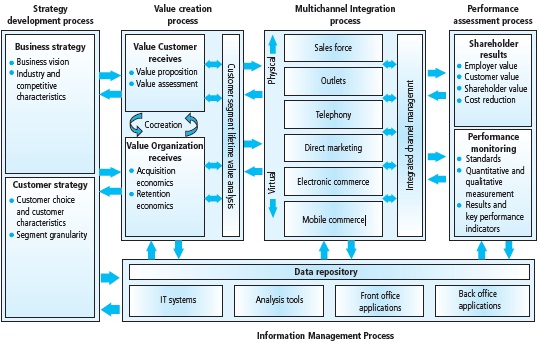
Figure 2.9: The Strategic Model for CRM (Payne, 2006).
Payne (2006) also introduced a strategic framework/model (Figure 2.8) for Customer Relationship Management CRM consisting of five generic processes such as Strategic Development, Value Creation, Multichannel Integration, Information Management, and Performance Assessment.
The Strategy Development process is concerned with integrating the business strategy from the organization angle and the customer strategy as to how firm interact and choose their customers. The Value Creation process with the main purpose of identifying the value the firm can create for the customer and the value the organization can also benefit from.
The Multichannel integration consists of all the virtual and physical channels with which the firm plans to interact with. But the main thing here is that, regardless of the channel contact, the aim is to create an experience that is uniform and also common.
The Information Management process consists of many different of data repository IT systems, back and front office applications and analytical tools. It is thus necessary to access the visibility of the system so the need for performance assessment process set in and it is concerned at the strategic monitoring can be used to determine customer satisfaction and standards.
Various authors have proposed Customer Relationship Management CRM strategy framework. Buttle (2001) provides a Customer Relationship Management CRM value chain that identifies a series of ‘primary stages’ highlighted above. These are helpful as it considers implementation issues.
Sue and Morin (2001) develop a framework for CRM based on initiatives, expected results and contribution. However, this framework is not process-based and, as the authors acknowledge, many initiatives are not explicitly identified in the framework.
Winer (2001) outlines a model, which contains: a database of customer activity; analyses of the database; decisions about customers to target; tools for the customer targeting; how to build relationships with the targeted customers; privacy issues’ and metrics for measuring the success of the Customer Relationship Management CRM program.
All these frameworks provide some useful insights; however Payne and Frow (2005) argue that none appear to adopt an explicit cross-functional process-based conceptualization; they used an expert panel of executives with the extensive experience within the CRM and IT sectors to identify specific cross-functional processes.
Thus the both authors identify five CRM processes including: strategic development; value creation; multi-channel integration; information management; and performance assessment (figure. 2.7).
2.2.5 The Dasai et al /Conceptual Model
The conceptual framework was developed by Dasai el al (2007) in which consideration is driven towards competitive CRM performance from both internal and external perspectives.
The dynamic capability for CRM is the key source for competitive CRM performance considering the rapidly changing nature of the business environment today which erodes the values of existing competencies (figure.2.8 below)
Figure 2.10: Conceptual Model (from Desai et al., 2007)
The figure 2.8 above comprises resources re-configurability, social networking capability and market orientation as the drivers of dynamic capability for CRM.
While the IT variables which are the CRM technology and knowledge management are the moderators linking the relationship between dynamic capability for CRM and competitive CRM performance.
As such, the direct impact of IT competence variables should be tried and seen on competitive CRM performance.
2.2.6 The Forrester Model
The Forrester CRM model is grouped into four types such as: Strategy; Process, Technology; and People.
The model produced results in the findings on over hundreds of companies using CRM as strategically, thorough analysis of over number of vendors’ solutions providers and also with discussion with about numerous consultants.
For firms willing to kick-start their CRM programs or for those that are finding it tough to get best out of their CRM programs after it has been launched.
Also, the performance scorecard (figure 2.9) highlights the criteria used by companies to measure the overall performance using CRM.
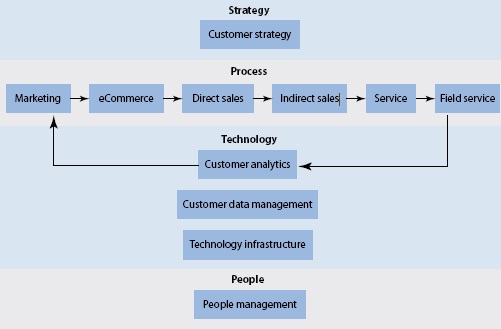
Figure 2.11: Forrester CRM Model (from Forrester Research, 2008)
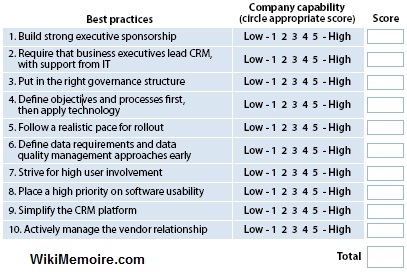
Figure. 2.12: CRM Performance Scorecard (Forrester Research, 2008)
The author notices that the above scorecard looks similar that produced by Gartner Group (IDM, 2002). Yet, few criteria were used.
Thus it should be suitable to assert the Forrester’s CRM performance scorecard is an improvement of Gartner’s one.
Table 2.1 presents Gartner performance scorecard. 
Table 2.1: Gartner’s CRM Performance Scorecard (IDM, 2002)
2.2.7 The CRM Maturity Model
Gartner’s CRM Maturity Model is a tool in which the group used in rating enterprises in terms of their capabilities in effectively using CRM.
To determine the category in which an enterprise is placed on the model, they are first evaluated in terms of Overall CRM vision and strategy, consistent valued-customer experience, organizational collaboration, processes, information, technology, metrics.
All these elements were what composed of the Garner’s performance measurement scorecard which was discoursed earlier on but the difference is that, haven scored your performance based on this elements, the maturity model will then enable the firm to know where they are at the present and where they want to be over a period of time, what the requirement they will need to achieve that status.
It is a very useful tool as each enterprise, that aims to satisfying their customer and also to maintain a lead in its industry, should make use of maybe at every set intervals. Table 2.2 shows what the model is looks like.
Table 2.2 shows what the model looks like. 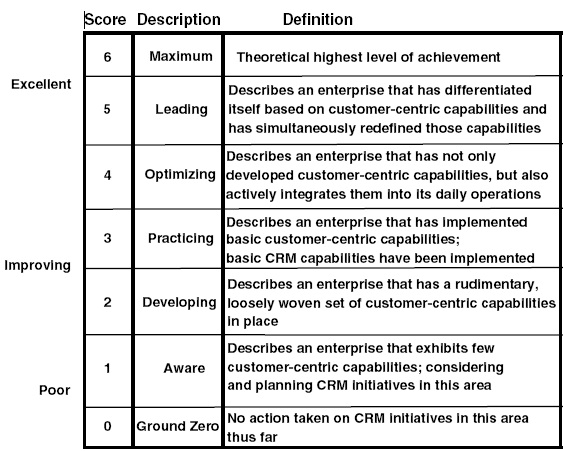 Table
Table
2.2: Gartner’s CRM Maturity Model for Enterprise (Gartner Group, 2001)
From the frameworks analyzed above, it was observed by the researcher that there are similarities which cut across them. Using Forrester Research as a benchmark and placing frameworks by Dasai et al and Payne on both sides of Forrester’s framework, each of the components in the framework were linked together, making it clear that they all similarly have in them all the four elements components of Forrester’s framework.
Dasai Framework Forrester Framework Payne Framework Strategy Process Technology People Customer Focus Organization Focus Dynamic Capability of CRM CRM Technology Knowledge Management Industry Control Strategy Development Value Creation Multi-channel Integration Information Management Performance Assessment
Figure 2.13: Different Frameworks Summary (By the Author)
The Figure 2.13 above shows what each of these frameworks contains. Looking at the strategy, this is focused on customer and organization in one side; and strategic development and value creation on the other side.
A successful company should understand how the customer base can be turned into an asset through the delivery of a value proposition. According to Close et al (2001), it provides objectives, segments and customers, and it should define how resources will be used interactions.
Respectively the organization, this involves the change of culture, structures and behavior in order to ensure that the staff, partners and suppliers work together to deliver what is promised. However, the researcher will only consider the Forrester’s framework as a basis of our further research.
